Many people use a gel or foam-filled cushion at their mouse, to alleviate pressure across the carpal tunnel. Recently, we came across a new product, invented in London Ontario, that aims to address this pressure issue by cushioning the carpal tunnel using an adhesive pad. Is this the answer?
Why does the pressure across the carpal tunnel exist? In our experience, this problem occurs because the mouse is used on a surface that is too high or too far away. If your elbow is not resting against the side-seam of your shirt, then your shoulder muscles must work to hold your hand out. This causes fatigue and discomfort, and the natural response to tired and sore shoulder muscles is to rest the weight of your arm on whatever surface is available.
Why is it bad to rest your arm? It isn’t always harmful to rest your arms on the desk, but if your wrist is bent (which happens when your keyboard or mouse is too high or too low, or if you’re resting on a hard edge such as the corner of your desk or table), then you increase the pressure on that nerve that is involved with carpal tunnel syndrome. 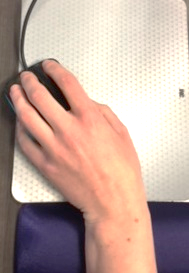
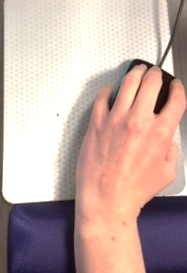 In addition, when you rest your forearm on a wrist rest at the mouse, you will control the mouse with a “windshield wiper” wrist motion (shown at right), which can lead to new wrist problems. Now that many people use multiple screens, we’re using our mouse to drive the cursor longer and longer distances. This can result in very repetitive wrist motion, if the wrist is “planted” on a wrist rest.
In addition, when you rest your forearm on a wrist rest at the mouse, you will control the mouse with a “windshield wiper” wrist motion (shown at right), which can lead to new wrist problems. Now that many people use multiple screens, we’re using our mouse to drive the cursor longer and longer distances. This can result in very repetitive wrist motion, if the wrist is “planted” on a wrist rest.
Our recommendations? Before you purchase a wrist rest for your mouse, please:
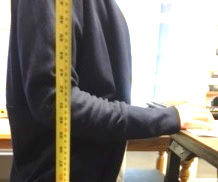 1. Confirm that your keyboard and mouse are at elbow height. (Literally, measure!) This should correct any tendency to bend the wrist while keying or mousing. (You may need to adjust your keyboard/mouse height, seat height, and foot support in order to accomplish this, but it’s really, really important! Set the mouse/keyboard surface at the same height as the bottom of your elbows, with your shoulders relaxed.)
1. Confirm that your keyboard and mouse are at elbow height. (Literally, measure!) This should correct any tendency to bend the wrist while keying or mousing. (You may need to adjust your keyboard/mouse height, seat height, and foot support in order to accomplish this, but it’s really, really important! Set the mouse/keyboard surface at the same height as the bottom of your elbows, with your shoulders relaxed.)
Just to show you how important this is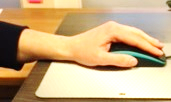 , we photographed Josie’s hand and wrist with her mouse at exactly elbow height (at right). The photos below show the postures with the mouse 4 cm (less than 2″) too high or too low.
, we photographed Josie’s hand and wrist with her mouse at exactly elbow height (at right). The photos below show the postures with the mouse 4 cm (less than 2″) too high or too low.
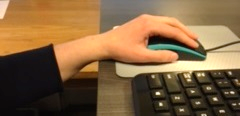

2.  Confirm that your mouse is the right size for your hand. When your forearm is resting on the work surface, the mouse should fill your hand, with the pads of your fingers on the buttons, as shown at right. A too-small mouse will leave a gap under your palm, creating a claw-like posture, as shown below left. A too-large mouse will not allow your forearm to rest on the desk. Mice have lots of other features, which benefit some people, but that’s a topic for another day.
Confirm that your mouse is the right size for your hand. When your forearm is resting on the work surface, the mouse should fill your hand, with the pads of your fingers on the buttons, as shown at right. A too-small mouse will leave a gap under your palm, creating a claw-like posture, as shown below left. A too-large mouse will not allow your forearm to rest on the desk. Mice have lots of other features, which benefit some people, but that’s a topic for another day.
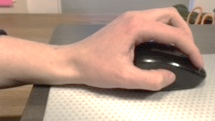
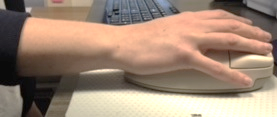
3. 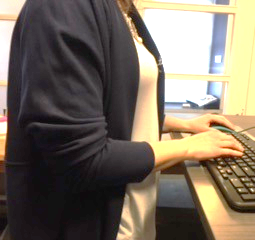 Keep the mouse and keyboard close. Your elbows should rest right beside your body while typing and mousing as shown at right. Some people have space between the body and the hands for a wrist rest, while others don’t. If you want a wrist rest, we recommend using one only at the keyboard, and only while reading the screen, not while typing. Your arms should float above the keyboard when you type. Your mouse should be moved long distances using the shoulder muscles, while sliding your forearm along the surface. Another problem with a wrist rest for the mouse is that it often increases the forward reach, resulting in a higher demand on the shoulder.
Keep the mouse and keyboard close. Your elbows should rest right beside your body while typing and mousing as shown at right. Some people have space between the body and the hands for a wrist rest, while others don’t. If you want a wrist rest, we recommend using one only at the keyboard, and only while reading the screen, not while typing. Your arms should float above the keyboard when you type. Your mouse should be moved long distances using the shoulder muscles, while sliding your forearm along the surface. Another problem with a wrist rest for the mouse is that it often increases the forward reach, resulting in a higher demand on the shoulder.
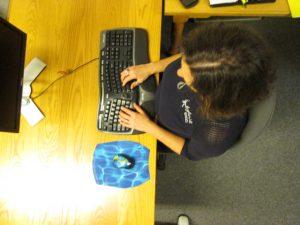 4. Consider using the mouse with the left hand, so you don’t have to reach past the numbers and arrows. For us “righties”, left-mousing is also great for providing space on the hand-dominant side for writing or for your devices.
4. Consider using the mouse with the left hand, so you don’t have to reach past the numbers and arrows. For us “righties”, left-mousing is also great for providing space on the hand-dominant side for writing or for your devices.
5. Use your arm, wrist, and hand efficiently. When the cursor needs to travel far, use your arm to move the mouse, not your wrist. Your forearm should slide over the worksurface. (This technique is admittedly easier on a “solid” surface than on a mouse tray, but a good mouse tray should support your forearm for this action.) Use the wrist for “medium” cursor travel, and your fingers for precise adjustment.
6. 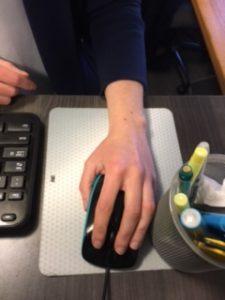 Make sure your mouse has enough space to move. The mouse needs to be able to move the full width of at least once screen without being lifted and moved back to the other side of the mouse pad. Most “mouse pads” are wide enough, but if your keyboard tray or desk doesn’t allow enough space for a standard mouse pad, consider a larger tray, or rearrange your desk to allow space. You can also experiment with the “speed” of the mouse, in your control panel settings, to change how fast the cursor moves on the screen, if you use two screens and your cursor needs to move a lot.
Make sure your mouse has enough space to move. The mouse needs to be able to move the full width of at least once screen without being lifted and moved back to the other side of the mouse pad. Most “mouse pads” are wide enough, but if your keyboard tray or desk doesn’t allow enough space for a standard mouse pad, consider a larger tray, or rearrange your desk to allow space. You can also experiment with the “speed” of the mouse, in your control panel settings, to change how fast the cursor moves on the screen, if you use two screens and your cursor needs to move a lot.
7. 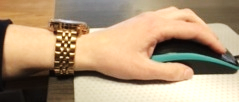 Don’t wear a watch on your mouse hand. Pressure against your wrist from the watch band will prevent you from sliding your forearm along the surface.
Don’t wear a watch on your mouse hand. Pressure against your wrist from the watch band will prevent you from sliding your forearm along the surface.
Before you invest in another gadget, use these tips to review your mousing posture, and adjust your workplace to you. That is, after all, the definition of “ergonomics”!
I think the design goals of the wrist rest we saw online is to cushion the wrist, to raise the wrist higher so that the forearm and hand are aligned, and to reduce friction between the mouse surface and the forearm. In our experience, modifying the task and workstation, as described above, will usually achieve these goals, without requiring you to “stick on” a device in an attempt to fit yourself to the workplace. (Which, by the way, fits the employee to the work, the opposite of the definition of ergonomics!)
We’re happy to help you to investigate the source of your “mouse pain”, and to personally encourage employees to apply these tips. Call us for info on our office ergo assessments, or our one-hour workshops and job-coaching (personal one-on-one quick sessions with employees).

